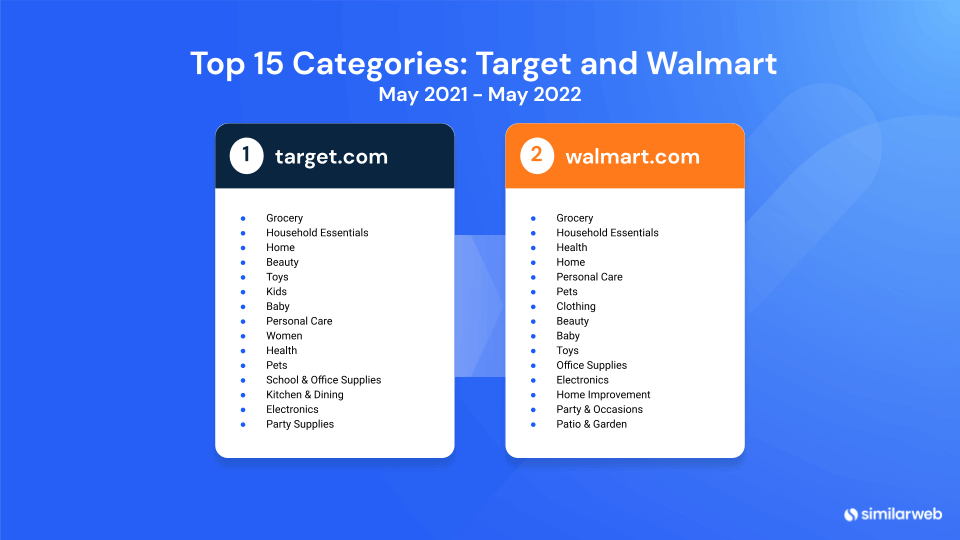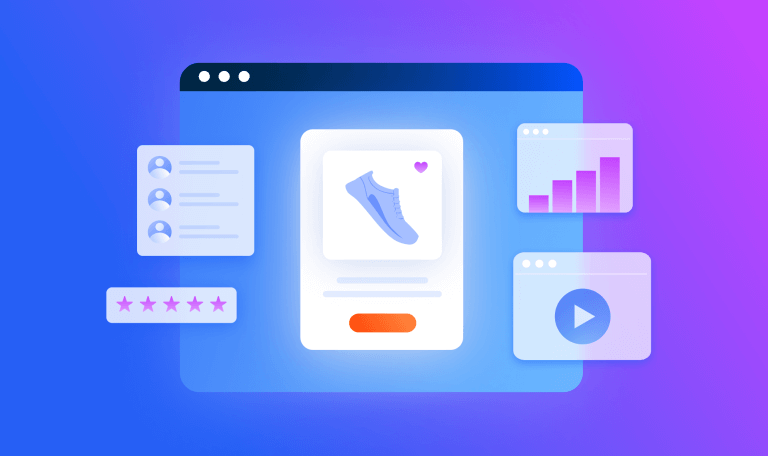Target vs. Walmart: What Every eTailer Needs to Know

Given the vast amount of online retailers in the eCommerce world, it can be extremely daunting to begin thinking about which online marketplace you should list your products on.
After all, when weighing out the pros and cons, there are many factors to think about: What online retailer does my target audience visit most frequently? Which site provides my audience with the best user experience? Which marketplace makes the most sense for my company?
We’re using the Similarweb Research Intelligence platform and our Shopper Intelligence platform to help you determine the best marketplace for you.
So, selling on Target vs. Walmart – let the eCommerce battle commence.
What’s the difference between Target and Walmart?
Despite both being established as household names in the eCommerce marketplace, there are a few key differences between Target and Walmart.
In terms of website traffic, Walmart takes the third spot on the top 10 eCommerce sites in the US, whereas Target falls lower on the list, ranking sixth.
In terms of revenue and units sold, Walmart also wins the battle between the two merchants. With help from the Similarweb Shopper Intelligence platform, we can see that over the past year (May 2021 – May 2022):
- Walmart.com sold 4.8 billion units, cashing in $27.6 billion in revenue
- Target.com sold 1.4 billion units, bringing in $19.3 billion in revenue
Another key difference is the process of becoming a third-party seller on the platforms.
Walmart launched Walmart Marketplace in 2009
- The platform now has over 130K third party-sellers, with thousands more joining every month.
- The vast amount of sellers generates high revenues on Walmart but also means there is fierce competition to sell your stock as customers have a plethora of pages to search through and products to choose between.
Target launched Target Plus in 2019
- Target stands out from its competitors by operating on an exclusive, invite-only system for third-party sellers, focusing on trusted, handpicked brands.
- Target Plus is so exclusive that there are only 450 sellers listed on the site, with around a dozen joining every month.
- Despite the challenge of listing your products on Target, being a third-party seller on the platform will prove your brand is reputable and trustworthy. It’s also a less competitive space than Walmart, as customers have fewer products to choose from.
Let the data talk – Target vs. Walmart:
Overall, walmart.com is the traffic winner. The site brought in 5.6 billion total visits in the US between May 2021 – May 2022. In comparison, target.com had 2.6 billion total visits in the same period. Both digital retailers sustained steady levels of traffic throughout the year, peaking during holiday sales in November and December.
Whilst website traffic might be seen as the main measurement of success given it provides you with an overview of a website’s popularity, this is only a partial view of online marketplace performance.
Keep reading to learn how other factors impact the suitability of digital retailers for your business.
Engagement metrics
Engagement metrics provide you with an idea of how your content is performing, and how visitors interact with your website. Analyzing engagement metrics is especially important in eCommerce: the more engaged users are on your site, the more likely they are to make a purchase.
There are four key website metrics you should look out for:
- Session duration: A longer session duration means your visitors are engaged and spending more time on your site.
- Average pages per visit: The higher the number, the more content your visitors are browsing through while on your site.
- Average bounce rate: The percentage of visitors who enter a site and then leave after viewing just one page. A lower bounce rate means that your content is relevant to your visitors.
- Unique visitors – The average number of individual users who visit your site in a specific amount of time to give you an estimation of how often people return to your site.
As you can see from the screenshot above, overall Walmart performs best with higher monthly visits, monthly unique visitors, visits, and longer visit duration in comparison to Target. However, Target earns more pages per visit and has a lower bounce rate.
The data shows that by listing on Walmart, your brand is likely to gain a lot of exposure to new audiences daily, whereas with Target your brand will attract a more loyal audience.
Device split is also an important metric to keep an eye on. Device split allows you to track the way your visitors come to your site.
Target and Walmart have a similar device split, both leaning towards attracting higher mobile traffic and therefore a younger demographic. If you have a strong mobile presence and also tailor to users on desktop, then both of these marketplaces are suitable for your brand. In this case, device split won’t be a determining factor when choosing between the two.
Audience demographics
As you can see, Target attracts a larger female audience, at 62%, whereas Walmart has a more equal split between genders.
In terms of age distribution, Target and Walmart have a similar age demographic split.
However, when analyzing the data further we can see that Walmart’s audience skews slightly older than Target, with 60% of its audience over 35+ in comparison to 54%. As you can see in the chart above, Target attracts a younger audience than Walmart.
Marketing channels
Direct marketing is the main source of traffic for both Target and Walmart, sending 525.6 million and one billion visits to each site respectively from May 2021 – May 2022. Both sites fall way above the eCommerce industry benchmark of 9.7 million visits.
When accounting for traffic share across all marketing channels, direct traffic brings target just over half of its traffic share with 50.8%, and Walmart just under half of its traffic with 48%.
Organic traffic is the second driver of traffic for both sites, bringing Target 29.8% and Walmart 30.8% of traffic share, both just above the industry standard of 29.4%.
Top categories
Whilst the metrics show Walmart is the most profitable, this doesn’t necessarily mean it’s the best place to list your products.
For items that fall under groceries, household essentials, and home, there’s not much difference between which marketplace you choose to list on. However, Target is more focused on beauty products whereas Walmart is more focused on health.
Selling requirements: Which suits you best?
Selling fees
Walmart Marketplace:
To sell on Walmart there are no setup or monthly fees. Instead, Walmart operates on a “pay for what you sell” service, with a referral fee deducted from each purchase.
Referral fees vary by category and are determined by the product types you choose when listing your items. Whilst each category has its own commission rates, they range between 6% to 15%.
Target Plus:
Similar to Walmart Marketplace, Target has no hidden charges or fulfillment fees. Sellers just pay a commission rate or referral fee that falls between 5% to 15%.
Shipping and fulfillment
Walmart Marketplace:
A core requirement of selling on Walmart Marketplace is to have a fast and predictable fulfillment network. With its TwoDay and ThreeDay seller programs, your products will stand out in customer search results.
On top of this, Walmart has launched Walmart Fulfillment Services (WFS). With WFS, you send your inventory to a Walmart Fulfillment Center where they store, pack, and ship your orders – guaranteed to be delivered to customers within two days. Added bonus: Walmart handles customer care for you.
If you’re unable to organize fast shipping, Walmart might be the most convenient marketplace for you.
Target Plus:
On the other hand, Target Plus does not have a fulfillment service for third-party sellers, so merchants are required to ship their own products.
All orders must be shipped within 24 hours after purchase, and arrive to the customer within five days. Although this might drive customers to find a site that guarantees faster delivery, this is your chance to stand out in the Target marketplace. This gives you room to increase your competitiveness further, but offering next-day or two-day delivery.
Payment methods
Payment methods available to customers buying from third-party merchants on Walmart Marketplace include:
- Debit card
- Credit card
- Gift card
- PayPal
- Affirm
Payment methods available to customers buying from third-party merchants on Target Plus include:
- Debit card
- Credit card
- Gift card
- Afterpay
- Klarna
- Zip
- Affirm
- Sezzle
So, who should you choose?
Now that you’ve seen the pros and cons of Walmart vs. Target, you should have a better idea of how your goals align with what the marketplaces offer. Our advice is to prioritize the factors that are integral to your business and go from there.
If your target audience skews slightly older and you need support with shipping, Walmart is for you. Whereas Target might be your best bet if your desired audience is female-orientated, and a younger demographic.
To learn more about using Similarweb to track your performance online, schedule a demo of Digital Research Intelligence and Shopper Intelligence today.
Further reading
Interested in seeing how other eCommerce marketplaces stack up? Check out some of our other blogs to learn more:
- Shein vs. Amazon – Is Fast Fashion Dressed for Success?
- Amazon vs. Walmart: The Race to the Top
- AliExpress vs. eBay: The Battle for Global Market Share
- Selling on Amazon vs. eBay: The eCommerce Showdown
- Ulta vs. Sephora: Which is the Best Fit for Your Brand? (+ Top Brands Ranked)
- Amazon vs. Shopify: Which Is Better in 2022?
FAQ
What’s the difference between selling on Target vs Walmart?
Walmart Marketplace has a vast amount of sellers listed on the platform generating high revenues. Target Plus works on an invite-only system, making it an exclusive marketplace to sell on, however, this means there is less competition between listed brands.
How do I decide which marketplace to list my products on?
To decide which marketplace to list your products on, research the features each marketplace has to offer and choose which marketplace compliments your brand best.
What factors are important to consider when deciding which marketplace to sell on?
There are many factors to consider when deciding which marketplace to sell on, including selling fees, shipping requirements, website metrics, audience demographics, and top-performing categories.
The ultimate edge in marketplace intelligence
Put the full picture at your fingertips to drive product views and sales











